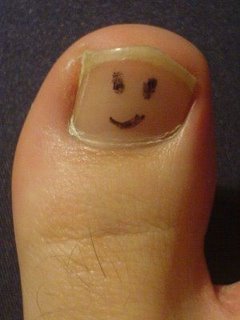Big Toe Woes: One way to learn to load the head of the 1st metatarsal
On Thursday morning, while sprinting up a hill on the latter part of a run, I had the fortuosity of catching my big toe on what I beleive was an exposed root and fell sudddenly. Instinctively I rolled to protect my back (as you often do if you have had any history of back injuries). After a few expletives and a bruised ego, I took inventory of my body: back was fine, an abrasion and contusion on my left elbow and a really sore big toe. I got up and decided to run home as I was less than a mile from there.
I immediately noticed that my gait would need to be altered if I was going to make it home. I had injured the distal interphalangeal joint and distal phalanyx from the best I could tell; loading them in any way brought excruciating pain, so I was forced into one of my mantra’s: “Keep your toes up”*. I did this for the rest of my run and noticed, probably more than ever, how much this simple technique shifts the weight to the head of the 1st metatarsal and sesamoids. It also made me make my gait more “circular” (rather than pendular, another thing we teach in gait retraining).
I made it home and promptly iced. After getting to the office, an X ray confirmed my suspicion of a fracture in the proximal portion of the distal phalanyx. A day later and from my distal to my 1st metatarsal phalangeal joint is sausage like and a beautiful violet color. I am grateful I did not seem to injure the MTP…Oh well, I will either have to run carefully or switch to mountain biking for the next few weeks. Some ipriflavone (to assist in calcium absorption), cucumin and essentail oils (for inflammation) and I was good to go. Yes it throbs a bit, but it is a reminder that I need to push off through the head of the 1st : )
Try “toes up”with your peeps and let us know how it goes.
TGG
* “Toes up” technique involves conciously firing the anterior compartment muscles, particularly the extensor digitorum longus. It fires more into the extensor pool and assists in firing ALL your extensors through spacial and temporal summation and also heps to shut down flexor tone through reciprocal inhibition. It will also help you to rocker through your stance phase and get more into your hip extensors.



 Did you know that the EHB (extensor hallucis brevis) the topic of today’s video tutorial, originates off of the forepart of the medial aspect of calcaneus & lateral talocalcaneal ligament. It is just above the bulk origin of the EDB (extensor digitorum brevis). It is frequently torn/strained in ankle inversion sprains and frequently goes undiagnosed. It can be torn/avulsed from the bone if the inversion sprain is focused below the lateral ankle joint. This occurs mostly when the foot is more plantarflexed before the inversion event. A foot cannot afford to have an impaired big toe ! Don’t miss this one !
Did you know that the EHB (extensor hallucis brevis) the topic of today’s video tutorial, originates off of the forepart of the medial aspect of calcaneus & lateral talocalcaneal ligament. It is just above the bulk origin of the EDB (extensor digitorum brevis). It is frequently torn/strained in ankle inversion sprains and frequently goes undiagnosed. It can be torn/avulsed from the bone if the inversion sprain is focused below the lateral ankle joint. This occurs mostly when the foot is more plantarflexed before the inversion event. A foot cannot afford to have an impaired big toe ! Don’t miss this one !












